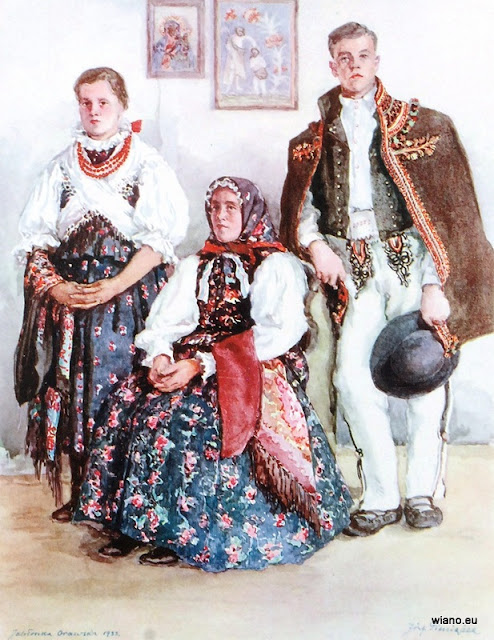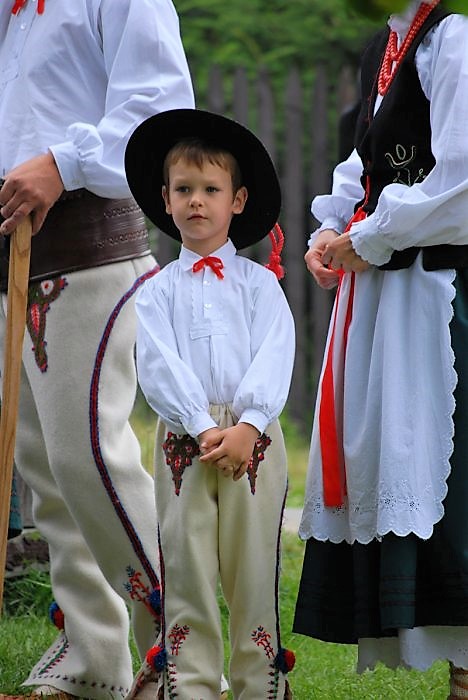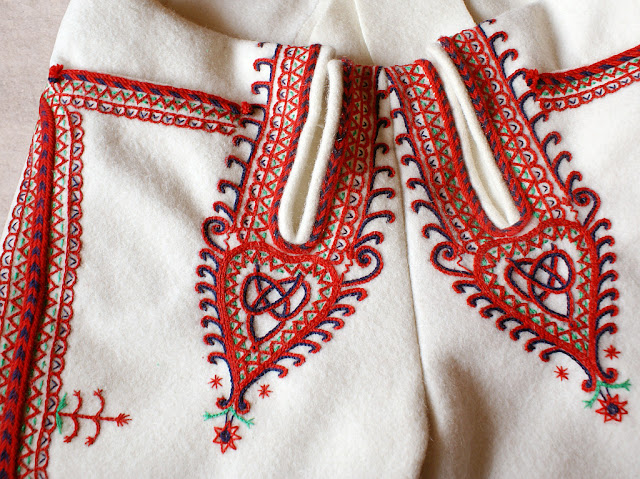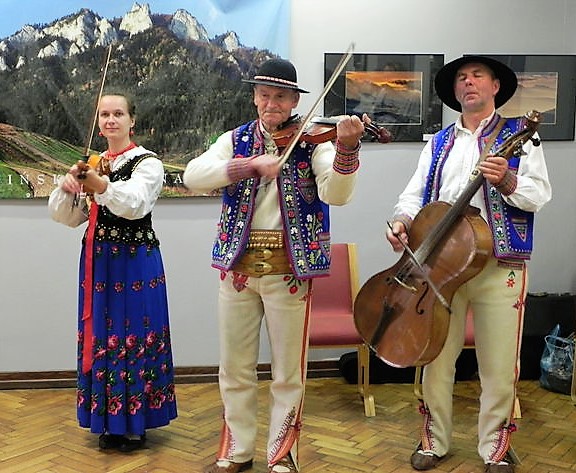Hello all,
Today I will talk about the costumes of the Górale, or Gorali. In English often called Gorals. This just means mountain people. In English Gorals often refer to themselves as 'Polish Highlanders'.
The Gorals are one of the four Slavic tribes found in the Carpathian mountains. In Ukraine, on and over the Romanian border live the Hutsuls, on both sides of the mountains west to the rivers Limnytsia north of the mountains and the river Teresva south of them. The Boikos live west of that line, through Ukraine into southeastern Poland up to the river Sian [San] north of the mountains and the river Uzh south of them. The Lemkos [Rusyns] live west of that line up to a point between the villages of Szlachtowa and Szczawnica on the Polish side, and between the villages of Veľký Lipník and Lesnica on the Slovak side. The Górale live west of that point through south central Poland and also on the Slovak side into the southeasternmost corner of Silesia, both in Poland and Moravia.
I always wondered why there seemed to be no native Slavic tribe in the mountains between Poland and Bohemia, but recently learned that they were not considered part of the Carpathians. The Górale are restricted to the Western Carpathians.
Of these four tribes the Gorals are of West Slavic origin, while the other three are of East Slavic origin. They are generally considered to be Polish, although Slovakia and the Czech Republic often consider the Gorals on their side to be of their own nationality. They speak their own group of dialects which are quite distinct.
The Gorali are divided into several groups, which vary somewhat according to the source consulted. Here is one rather good map of their distribution. The one issue that I have with this map is that they show an island of khaki green on the east, which is traditionally the territory of the Szlachtowa Lemko / Rusyns. It seems that after they were ethnically cleansed from the area, their lands were settled by Podhalany.
The stippled areas in the south are those in which the Goral population lost, at least in part, their Polish ethnic identity, coming to consider themselves Slovak Gorali.
The costumes of the various groups are distinct, but have a lot in common. The women's outfits show much similarity in their variety. It is often easier to identify the origin of people by looking at the mens' costumes, in particular the ornament on the pants. The mens' pants are always of very heavy naturally 'white' wool, which is actually more of a cream color. The ornamentation on the pants, especially of the parzenica, the front opening, is distinct from one group to another. I will proceed west to east.
Górale śląscy - Silesian Gorals
These people are represented by the orange area at the left of the map, being found south of Cieszyn on both the Polish and Moravian sides.
https://en.wikipedia.org/wiki/Silesian_Gorals
The women generally wear no bodice, and a short shirt over a long chemise. The apron is traditionally indigo-batik print. The skirt is black and pleated. The men wear simple pants with only one front opening, which is edged with braid. The vests are red, or occasionally black for older men. Both men and women have negative space cross stitch embroidery on the shirt, usually in a chestnut and black for the men and red or maroon for the women. The woman on the right here is wearing completely non traditional embroidery.
Students from the local university doing dances of this group. Note the boys' games.
https://www.youtube.com/watch?v=Zf-lAO9RUpI
A village group from this area performing in Podhale. less polished, more authentic.
https://www.youtube.com/watch?v=qmE5MwIiD38
Górale czadeccy - Chadets Gorals
These people live to the south of the Silesian Gorals, across the border in Slovakia, in the Kisuca valley. It is likely that they were of the same origin as the Silesian Gorals, but have been influenced by Slovak culture and costume. This is especially evident in the colorful embroidery.
https://pl.wikipedia.org/wiki/G%C3%B3rale_czadeccy
The pants are again very plain, with two flaps falling over where the openings would be. These sometimes have floral embroidery. Both mens' and womens' shirts have colorful embroidery.
Some dances of the Chadets Gorals
https://www.youtube.com/watch?v=Wi6kB1a_6NI
Górale żywieccy - Zywiec Gorals
This group is represented by purple on the map above. They live south of the town of Żywiec up to the Slovak border. They, and the rest of the following groups form part of the macroregion of Malopolska rather than Silesia.
https://pl.wikipedia.org/wiki/G%C3%B3rale_%C5%BCywieccyThe women wear a malopolska style bodice, called gorsetka. It is in various colors with a floral stem or group embroidered on the front and back, lappets, either round or squared off, and is laced with a red ribbon. They wear an apron, usually of white cutwork. The men wear either red vests with blue pompoms, or blue vests with red pompoms. the pants may have one or two openings in front, with relatively modest embroidery around the opening, and also some on the lower legs just above where the socks cover the lower part.
A song of the Zywiec Gorals
https://www.youtube.com/watch?v=Lscp2vPArGk
Górale Orawce - Orawa Gorals
These people are represented by light red on the map above. They live on both sides of the border, the Polish side being to the east of the Slovak side. This forms the northernmost part of the former Árva County of the Hungarian Empire.
https://en.wikipedia.org/wiki/Orava_(region)
The women wear a bodice which is closed up the front and has a peplum rather than lappets. It is made of material which usally contrasts with that of the skirt, and may be quite dark. Generally an apron is not worn. The men have two openings on their pants which are ornamented with black braid, sometimes with a combination of heavy and fine braid. They generally wear black vests, and sometimes long brown wool embroidered jackets.
Some scenes from a festival in Orawa
https://www.youtube.com/watch?v=JhNOCG1mLJg
A dance performance which seems to be from Slovakian Orawa.
https://www.youtube.com/watch?v=GjkWqJ0oMtc&frags=wn
Górale babiogórscy - Gorals of Babia Góra
These people are represented by lavender in the center of the map above. They live to the north of Babia Góra, or Witches Mountain, on the Slovak Polish border.
Górale babiogórscy
https://en.wikipedia.org/wiki/Babia_G%C3%B3ra
The women wear a gorsetka with lappets and floral embroidery. The skirt is often indigo batik printed. The apron is of white cutwork. The men may wear a black vest but often omit it. The pants have two openings, which are ornamented with red and blue braid or chainstitch. The heavy brown jacket is often worn here as well.

https://www.youtube.com/watch?v=pB_xuM5GAkE
https://www.youtube.com/watch?v=HsEp7ATtCZc
Górale Kliszczacy - Klishchatsy Gorals
These people are represented by orange in the upper center of the map above.The live east of the Babiogorcy and north of the Podhalany. The mens' pants seem to be modestly ornamented, and the costume in general seems to be under pressure from the Podhale costume, which is much better known and is quite impressive. I know little about this group.
Songs and dances of the Klishchatsy Gorals
Some of the dancers are wearing Podhale costumes
https://www.youtube.com/watch?v=0YPxHmK5Zts
Górale podhalańscy - Podhale Gorals
This is by far the best known group. The images at the head of the article are of Podhale costumes. They are shown on the map in khakhi green. They live mostly in Poland, in the High Tatras, the main town being Nowy Targ, but also inhabit a small corner of Slovakia called Sucha Gora [Suchá Hora].
https://pl.wikipedia.org/wiki/Sucha_G%C3%B3ra_(S%C5%82owacja)
The couple dance from Podhale
https://www.youtube.com/watch?v=kO3FcS-4tXo
The Goral men's dance. Zbójnicki
https://www.youtube.com/watch?v=NTRngq0sZ4c
Podhale songs and music in better quality but no video
https://www.youtube.com/watch?v=gVj8fwaG700
Górale zagórzańscy - Transmontane Gorals
This group is represented in pink on the map above, just north of the Podhale region.
They live east of the Kliszczacy, and south of the lowland groups known as Lachy.
https://pl.wikipedia.org/wiki/Zag%C3%B3rzanie
The mens' pants have two openings and are embroidered, but not as heavily or in the same style as in Podhale. The ornamentation often features a heart motif at the bottom. They also wear embroidered sheepskin vests.
The womens' costume is very similar to that of Podhale.
Stage performance of a local Zagorzanie folklore group
https://www.youtube.com/watch?v=z7jsWeetIY4
https://www.youtube.com/watch?v=9sg7gzaSHRU
Górale sądeccy - Sącz Gorals
This group is also shown in orange on the map above, to the right. They live to the east of the Zagorzanie, and northeast of the Podhalane. You can see that they form two separate enclaves, which are sometimes divided into two groups: the Górale Łąccy or White Gorals in the west, and the Górale piwniczańscy, also called górale nadpopradzcy, or Black Gorals in the east. The general name indicates that they live south of the region of Sącz.
https://pl.wikipedia.org/wiki/G%C3%B3rale_s%C4%85deccy
Górale Łąccy
This is the group which lives south of Sącz and north of the Szczawnica region. The men wear white pants which have two openings, and extensive embroidery on the front, sides, and lower leg, in a very different style from that of Podhale, and more closely resembles the embroidery of Sącz. The men wear a vest which is dark blue, and highly ornamented in a unique style. The women wear an embroidered gorset and floral print skirt, similar to that of Podhale.
https://pl.wikipedia.org/wiki/G%C3%B3rale_%C5%82%C4%85ccy
Performance of a local group of Górale Łąccy.
https://www.youtube.com/watch?v=LVusHNXqPkw
Górale nadpopradzcy
This group lives on the Polish Slovak border surrounded on the west, east, and south by Lemko / Rusyns. They live in the villages of Pilhov and Mníšek nad Popradom in Slovakia just over the border as well. To the north lie the Lachy of Sącz and the Pogorzanie. They have the name of black Gorals because unlike all other Gorals, the men wear black or dark brown wool pants. The women wear indigo batik printed skirts, white aprons and gorsets trimmed with ribbon.https://pl.wikipedia.org/wiki/Czarni_G%C3%B3rale
Local group performing dances and songs of this region.
https://www.youtube.com/watch?v=aVxI9PUaMWA
Wegilia of the Black Gorals. A Christmas service interspersed with traditional Music.
https://www.youtube.com/watch?v=fM4Egh34TqY&list=PLaYvT9y_anTcrXKRDhzkqPSqKq_1MoNhr
Górale Pienińscy or Szczawnickimi - Pieniny or Szczawnica Gorals.
This group is represented by blue to the right of the map above. They also live over the border in Slovakia, in and around the villages of Červený Kláštor and Spišská Stará Ves.
This costume is also used by boatmen on the Dunajec river who take tourists on excursions on both sides of the border. Often only the vest is worn. The Szlachtowa Lemkos wore essentially the same costume. The men wear a blue vest with extensive floral embroidery. The pants have one opening and also have extensive floral embroidery. The women originally wore indigo batik printed aprons, and red striped skirts. The bodices were of a solid color with geometric embroidery. Today the women often wear something closer to the Podhale costume. In the Rusyn village of Veľký Lipník in Slovakia across the border, the women wear the same costume but the men do not. Likewise in some Slovak villages further west, men wear this same costume but the women do not. I have previously written a more in depth article on this costume.
https://pl.wikipedia.org/wiki/G%C3%B3rale_pieni%C5%84scy
http://folkcostume.blogspot.com/2015/05/costumes-of-pieniny-dunajec-region.html
Today the men have retained this costume, but the women have generally abandoned it in favor of something much closer to the Podhale costume. What a shame.
Songs and dances of the Pieniny Gorals. Some of the women are wearing the traditional costume, but most are in Podhalized costume.
https://www.youtube.com/watch?v=nxThJPK0xz8
https://www.youtube.com/watch?v=ed5165ILudE
Górale spiscy - Spiš Gorals
This group is shown in dark red in the lower right of the map above. A small part of this region is in Poland, and a larger part in Slovakia. There are two Goral costumes in the Polish part of this region and several in the Slovak. Spiš itself extends further to the south and includes a significant part of Slovak territory. There were also once German colonies in this area.I also covered this area in my articles on the Pieniny region.
https://pl.wikipedia.org/wiki/Spiszacy
Polish side
Gorals from Kacwin and Trybsz areas.
The men wear a green vest with tassels and distinct embroidery. The pants have two openings and are ornamented with braid in a unique style. The women's costume resembles the old Szczawnica costume. This costume is also worn in and around the villages of Matiašovce and Spišské Hanušovce on the Slovak side.
Dances from Kacwin. Hungarian influence is very evident, very nice Csardas.
https://www.youtube.com/watch?v=lzxz1C22SUY
https://www.youtube.com/watch?v=uygb1EuG1vk
Gorals from Jurgów
The men have pants with two openings, which are embroidered with floral designs. The women wear bodices with points in front and back, which is very common further south in Spisz. The women's shirt had either woven red stripes as in Szczawnica, or black embroidery on the sleeves.

Wedding dance and Zbojnicki by a village group from Jurgow.
https://www.youtube.com/watch?v=JZhQIEQiIfw
A Jurgow group performing at a festival in England
https://www.youtube.com/watch?v=iMcoZRVUDHo
Slovak Side
Here is a map showing the Goral villages in Spisz on both sides of the border. The isolated group at upper right wear the Black Goral costume. The villages close to the border in the center wear the Pieniny costume. Matiašovce and Spišské Hanušovce wear basically the same costume as Kacwin and Trybsz.
I will present two costumes which are from a bit further south and are distinct.
Ždiar
This lies to the southeast of Jurgow, south of the Rusyn ethnic island of Osturnia. The women's costume is somewhat similar to that of Jurgow, but the mens' is distinct.A short clip of Ždiarski Górali dancing.
https://www.youtube.com/watch?v=I4wBLWoWNqo
A stage presentation of a wedding in Ždiar.
https://www.youtube.com/watch?v=bTrvJDV7M7c
Here is a stage presentation by a Slovak troupe of a 'Goral' suite. For some reason the men are wearing Black Goral costumes and the women are wearing Ždiar costumes.
https://www.youtube.com/watch?v=Y-2KxiffcLc
Lendak
The mens' pants are embroidered in a similar manner to those of Jurgow, in spite of them being further away. The womens' costume shows significant influence from the Rusyn and Slovak costumes of the area.
A group from Lendak performing at a festival in Cleveland.
https://www.youtube.com/watch?v=pqwa8p4zLzU
Some video from a workshop of Goral dance taught by a couple from Lendak.
https://www.youtube.com/watch?v=kn927PaFUMs
Old video clip of songs and dances from Lendak.
https://www.youtube.com/watch?v=us0i_7_Mtxk
Scenes from a Goral festival in Zdiar. Goral groups from many districts in Slovakia participate.
https://www.youtube.com/watch?v=F6GUc5vrW20
Now when you meet a Góral you will be able to tell which region he comes from, and you will have a good excuse for staring at his pants.
Thank you for reading. I hope that you have found this to be interesting and informative.
Roman K.
email: rkozakand@aol.com
This material was gathered from so many sources that I cannot list them,
but here is one very comprehensive and interesting website on Polish costumes and embroidery.
http://polishcostumes.tumblr.com/regions

















































































































































































































































Thank you Roman, I enjoyed seeing the embroidered men's trousers in particular. Fancy pants indeed!
ReplyDeleteAre you looking for the finest collection of plus size cotton tops? Are you unsure whether or not you will be able to find the best one for you? If yes is what you might be answering then you should know that the modern day market is flooded with plethora of Plas size cotton tops.
ReplyDeleteQuick instant Online Payday Loans South Africa no paperwork come with facility of flexible refund features and are planned in such an approach that the needy person can reimburse the loan easily.
ReplyDeleteThis comment has been removed by a blog administrator.
ReplyDeleteGórale czadeccy originate from Cadca, Slovakia but have settled in the Romanian Bukovina in the early nineteenth century. The costumes shown are from the ones who live in Romania and they show Romanian, not Slovak influence.
ReplyDeleteThey refer to themselves as 'czadeccy' instead of 'bukowińscy' or 'rumuńscy' because Romania as an ally of the Nazis had negative associations in post-WW2 Poland.
DeleteBTW, Gorals are considered part of the Carpathians. Gorals also didn't have an ethnic identity other than Goral until the 19th century when people either chose the Slovak or Polish one so they never really lost it. Gorals in Slovakia are often considered an ethnic minority too. In Poland on censuses one of the nationalities that can be chosen is Goral. Losing Polish/Slovak ethnic identity is 1920s propaganda generated during the border disputes.
ReplyDeleteGorals are reffered as vlachs for centuries.
ReplyDeleteThe emigration of Romanians to southern Poland and Moravia began in the 10th century. Nestor's chronicle mentions that in the 10th century "the Hungarians drove out the Vlachs and took their lands"
Anyway great article btw!
ReplyDelete